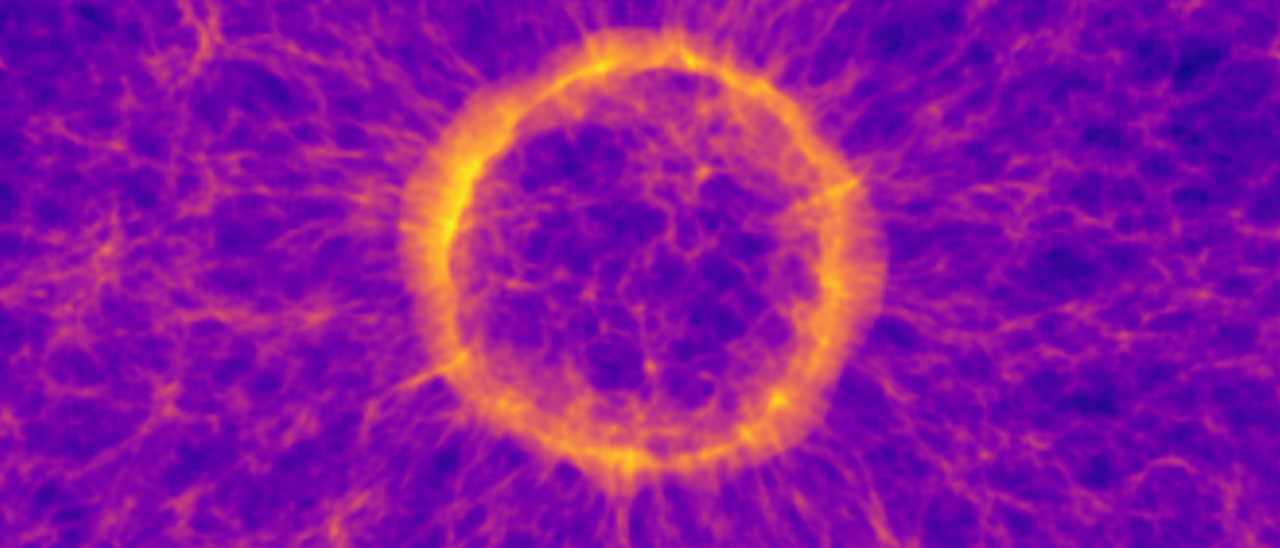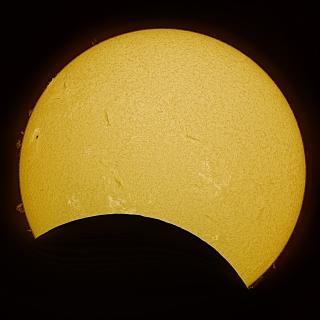The Instituto de Astrofísica de Canarias (IAC) in collaboration with the University of Geneva (Switzerland), the University of Osaka (Japan), and the University of Zhejiang (China) has made a key contribution to a more precise measurement of the expansion of the Universe. This is because they have made an improvement in the precision of the calculation of the scale of the universe in its early stages using the analisis of the distribution of gas in intergalactic space, measurements which reach back to epochs between 10,000 and 12,000 million years ago.
This result comes from the análisis of the absorption of light from quasars, which are supermassive black holes and extremely brilliant light sources by the intergalactic gas clouds between the quasars and ourselves as observers. These observations permit the detection and measurement of large scale oscillations in the density of the normal matter in the universe, the ‘baryon accoustic oscillations’, which provide a scale for the accurate measurent of distances. These patterns can be observed either in the distribution of the galaxies, or in the distribution of the gas. It is the second method which these observers have now been using.
This advance was achieved with the help of the mean of the results of around a thousand cosmological simulations, covering volumes of the Universe with sizes of thousands of millions of light years. The researchers explain that “the effect we discovered needs to be taken into account in future analyses in order to improve the estimates of the rate of expansion of the universe, and as a consequence to improve our understanding of the nature of dark energy".
Dark Energy Spectroscopic Instrument (DESI)
The team is participating in building theoretical models backed by data from the Dark Energy Spectroscopic Instrument (DESI), and the Prime Focus Spectrograph (PFS) on the Subaru telescope in Hawaii. The research has been published in The Astrophysical Journal Letters.
Current observations suggest that our Universe is composed predominantly of dark energy (which makes up some 73% of the total) and dark matter (some 24%) while the baryonic matter (what we think of as normal matter) provides only 4% of the total density. In spite of this small proportion, the baryonic mater plays a fundamental part in our understanding of cosmological evolution. This is because the main part of the information about how the Universe evolves comes to us from structures and bodies formed by ordinary matter, notably stars and galaxies, which can emit light, and other radiation,detectable by telescopes on Earth.
Baryonic Accoustic Oscillations (BAOs)
One of the most important cosmological signals used to study the evolution of the Universe is provided by the Baryonic Accoustic Oscillations (BAOs). These are oscillations produced with in the “primordial soup” of the primordial fireball after the Big Bang. At that time, the Universe was so dense and hot that the radiation and the matter were in close mutual interaction. As the universe cooled down, and the matter separated from the radiation, the latter continued to expand, and can be studied directly using the cosmic microwave background radiation.
The matter preserved the BAOs which can be detected because their scale size has been preserved as a clear peak in the distances between pairs of galaxies or their associated gas. This peak defines a scale which remains constant with time, (always allowing a factor for the expansion of the universe) and so provides a precise measurement of distances on cosmological scales. Combining this BAO scale with measurements of the velocities of the objects measured (galaxies or gas) gives an accurate way of testing cosmological models. The observations made by this research group have used the gas to give them a measured BAO scale.
BAO scale
The main result of this study has been the detection of the need for a systematic modification of the BAO scale. The exact technique detects the gas in the form of the Lyman alpha forest, a set of absorption lines in the spectra of the quasars, which provide the velocities of the complete set of gas clouds between ourselves and each distant quasar. This method is a powerful way to measure the three dimensional distribution of the principal objects in the Universe as a whole and in particular of the early universe when galaxies were forming.
This achievement was possible thanks to the generation of a thousand simulations, each one covering a large cosmological volume. Perhaps surprisingly each simulation lasted less than five minutes to run on a normal portable computer. These models could be calibrated against a couple of simulations with high computing cost, requiring some 200,000 hours of the CPU of a supercomputer.
“We hope that this result will make a strong impact on the scientific community. This effect had not been explored previously and marks an important milestone in this field. The study has already aroused great interest among our colleagues throughout the world”, says Francesco Sinigaglia, a postdoctoral researcher at the University of Geneva, the first author on the paper.
“We were confident that we would detect the effect, given previous findings related to cosmic voids”, states Francisco-Shu Kitaura, a professor at the University of La Laguna and an IAC researcher. The intutitive feeling that this effect should also be present in the Lyman-alpha forest motivated us to deepen our research, and this is the first time that this has been done. Now we are enthusiastic about exploring how to incorporate the effect into cosmological analyses, taking advantage of the experience of our group at the IAC”, he adds.
The result was obtained by averaging the observables in one thousand rapid simulations, a necessary step to obtain very precise cosmological information. “Generating this type of simulations is not a trivial task”, says Kentaro Nagamine, professor at the University of Osaka. “We based our work on models which we had developed over the years to make quick predictions about the Lyman-alpha forest but these models need calibration against more complex and costly simulations from the computational point of view”, he adds.
“As we foresaw, the complex cosmological simulations were essential to be able to make a rapid but precise prediction of the Lyman-alpha forest. We carried out a pair of ‘twin’ cosmological hydrodynamic simulations, among the largest ever produced”, states Yuri Oku, a postdoctoral researcher at the University of Zhejiang (China).
Peak in the BAO distribution
The peak in the BAO distribution is a fundamental measurement for many cosmological studies, so that it is essential to understand and take into account possible systematic effects in order to pin down cosmological models without bias.
“Developing a solid theoretical understanding of the BAOs is crucial for a precise análisis of the data from cosmological studies”, claims Francesco Sinigaglia. “Until now the BAO in the Lyman-alpha forest has been analyzed without taking into account this subtle effect. However from the precisión of the data we are obtaining, we are beginning to be sensitive to it. We are starting an epoch of cosmology with unprecedented precisión”, he adds.
The authors are planning to continue to characterize the effect they have discovered and to generate hundreds of large scale simulations of the Lyman-alpha forest, which will cover the whole sky. They hope that these simulations, which incorporate the effects discovered in the present study can establish a standard for the next generation of cosmologicla studies.
Article: https://iopscience.iop.org/article/10.3847/2041-8213/ad66bf
Contact at the IAC:
Francisco-Shu Kitaura: fkitaura [at] ull.edu.es (fkitaura[at]ull[dot]edu[dot]es)
Contact at the University of Geneva:
Francesco Sinigaglia: francesco.sinigaglia [at] unige.ch (francesco[dot]sinigaglia[at]unige[dot]ch)
Contact at Osaka University:
Kentaro Nagamine: kn [at] astro-osaka.jp (kn[at]astro-osaka[dot]jp)




